Peter Brannan in London
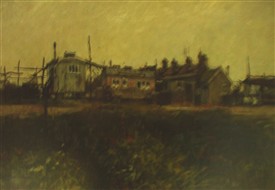
Caravans - fourth Trafford exhibition, 1967
Private collection: courtesy Artists's Estate
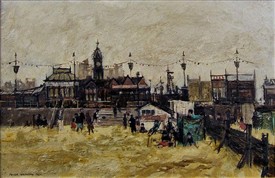
Coast Scene, Cleethorpes - third Trafford exhibition, 1965
Private collection: courtesy Artists's Estate
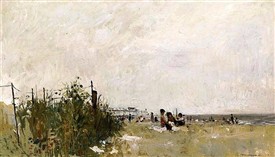
East Coast, beach scene - shared exhibition with Derek Mynott, Trafford Gallery 1959
Private collection: courtesy Artists's Estate
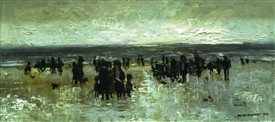
People and Carts near the sea - Second Trafford exhibition, 1962
Private collection: courtesy Artists's Estate
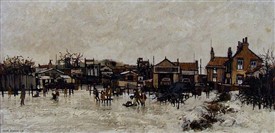
Playing on the ice - Fifth Trafford exhibition, 1969
Private collection: courtesy Artists's Estate
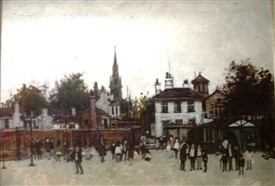
School Yard - Sixth Trafford exhibition, 1971
Private collection: courtesy Artists's Estate
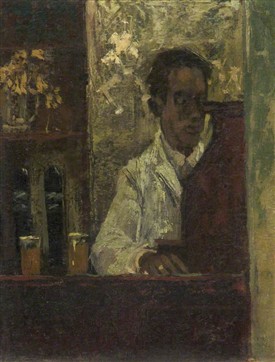
The Barman - First Trafford exhibition, 1960
(c) Manchester Metropolitan University Special Collections, courtesy Artists's Estate
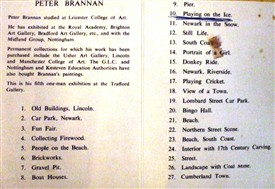
New Paintings by Peter Brannan - fifth Trafford exhibition catalogue, 1969
An artist connected with Notts and Lincs exhibits in London
By Dr Malcolm Moyes
Peter Brannan was a regular exhibitor at various venues in Lincolnshire between 1943 and 1994. His work was also shown in many galleries outside his native county, mainly in the South of England. As late as the 1990’s, he was still being offered gallery space by owners from beyond Lincolnshire, who clearly saw his paintings as a commercial proposition. In 1992, for example, Brannan exhibited around fifteen works at Old Luxtor’s Barn Gallery, in the Hambleden valley, near Henley-on-Thames, a number of which sold quite quickly to British and European clients.
Peter Brannan’s earliest outings in London were in April 1951, at the Foyle’s Art Gallery on Charing Cross Road, and in December 1952, at the Artists International Association (AIA) Exhibition, titled The Mirror and the Square: An Exhibition of Art ranging from Realism to Abstraction, at the New Burlington Galleries in Mayfair.
The exhibition of watercolours at Foyle’s was an exclusive showcase for selected members of the Lincolnshire Artists’ Society (LAS), which included Edward Brannan and his two sons, Noel and Peter, and received encouraging contemporary reviews. Two of the four watercolours exhibited by Peter Brannan, titled Landscape, near Chester and Landscape, near Hereford, were probably scenes encountered during his National Service in the Royal Army Medical Corps, between 1946 and 1947; whilst Covenham, St Mary’s and Cornfield, the two other pictures in the exhibition, drew upon the Lincolnshire landscape.
The AIA exhibition was much less localised and displayed work by a mixture of both established and up and coming artists, including Ben Nicholson, L S Lowry, Graham Sutherland, David Bomberg and Wyndham Lewis. Peter Brannan had two works in the exhibition: Café Interior and Barber’s Shop. A notice of Brannan’s success, published in the Lincolnshire Echo newspaper, provides a helpful description of the two paintings, in the absence of other contemporary documentary evidence. According to the article, the Café Interior depicted a pensive woman, a couple and a man reading a newspaper, against a background of a snack bar with mirrors; whilst the Barber’s Shop focused upon a man in the barber’s chair with customers waiting their turn for a haircut. The theme of small, sombre, public interiors relates the paintings to other known works of this period, such as Irish Bar Room Interior, dated 1951 and The Barman, dated 1955.
During the 1950’s, as well as in the early 1960’s, Peter Brannan also met with success in his submissions to the Royal Academy in London. In 1953, two of his works, Beach Scene (Exhibit 417) and Interior (Exhibit 455) were on display; whilst in 1954 he exhibited another coastal scene, Low Tide (Exhibit 362) and in 1956, a picture with the intriguing title of Children with Masks (Exhibit 696). In 1957, Newark Landscape (Exhibit 289) and Two Children (Exhibit 500) were accepted for hanging, and in 1958 the less specifically located Snowy Day (Exhibit 82) was also put up on show. Later success at the Royal Academy followed in 1960 with two contrasting paintings: Kitchen Interior (Exhibit 341) and Coal Mine (Exhibit 575). In the following year, Brannan again had two paintings exhibited: Newark School (Exhibit 113) and another Interior (Exhibit 711). His final exhibit at the Royal Academy, it seems, was in 1963 which was another coastal painting, East Coast Beach Scene (Exhibit 245); although he did submit other works for consideration after this date, none were accepted beyond the “Doubtful” stage of selection.
There are several other known London exhibitions in the 1950’s in which Brannan pictures were featured. Another AIA exhibition in 1954 showed at least one painting by Brannan, titled Jetty, a small oil on board which was later shown in the Daily Express Young Artists’ Exhibition in 1955. Also in 1954, Brannan shared an exhibition with the Kent artist Denis Lucas at the Irving Galleries, Leicester Square, in response to which one reviewer described Brannan’s work as “deeply reflective” and “pre-occupied with matters of deep human import”.
In 1955 and 1956, Brannan showed works at the Whitechapel Gallery, as part of the Pictures for Schools Project, a pioneering scheme to bring real art into the classroom. It was devised by Nan Youngman, artist, art teacher and active member of the AIA, who was driven by her staunch Socialist principles as much as by the ideas about child-centred education emerging in the post-war years, and their relationship to creativity. All exhibits were for sale to Local education Authorities for use by teachers and both of Brannan’s works, The Chimney Sweep and Winter Seascape, appear to have sold.
During the 1950’s, Brannan also showed his work with the London Group, probably as an open submission, rather than as a member. Like the London group, the Piccadilly Gallery on Cork Street, founded by Eve and Godfrey Pilkington in 1953, where Brannan also exhibited, encouraged relatively unknown artists who were looking for a gallery space to show their work. The Piccadilly Gallery, in its declared distaste for abstract art would have been congenial to Peter Brannan who shared the views of the Pilkingtons on the subject.
At the end of the decade, Brannan shared an exhibition at Charles Harding’s Trafford Gallery on Mount Street, Mayfair, with the London-born artist Derek Mynott. The review of the joint exhibition in the Arts News and Review noted in passing that Brannan exhibited six paintings, two of which were East Coast Beach Scene and On the Coast. Clearly, the reviewer was impressed by Brannan’s work, which he described as showing “a remarkable ability to lend a strange luminosity to drab colours and a nice appreciation of texture”.
The shared exhibition with Derek Mynott and its favourable critical reception, as well as the kudos of being elected to the Royal Society of British Artists, with its further opportunities to exhibit annually in the capital, on top of having work hung at the Royal Academy, may have paved the way for Brannan’s most impressive outings in London: a series of one-man exhibitions at the Trafford Gallery in the 1960’s and 1970’s, each one showing around twenty-five pictures.
In total, there were six one-man exhibitions: the first was held from 16th February – 12th March, 1960, and the final one from the 2nd – 26th November, 1971; in between those two sets of dates there were regular shows during the 60’s, in 1962, 1965, 1967 and 1969. The catalogues of these exhibitions are ephemeral minimalist productions which contain a brief biographical note on Peter Brannan, followed by a bare list of works on view, but without any prices. Given the flimsiness of the catalogues, it is not surprising that their survival has been very much down to lucky accident and good fortune.
The diversity of the 1960 exhibition in terms of theme and genre suggests a conscious attempt by Brannan to showcase his artistic versatility.
There are five works which reference the specific urban location of Newark, where Brannan lived and worked. Newark School (Exhibit 3), Street Scene, Newark (Exhibit 8), Newark Bridge (Exhibit 10), Mount Lane, Newark (Exhibit 13) and Newark Interior (Exhibit 26) represented his most concentrated showing of images of the town in a single exhibition so far. Two other paintings, Lincoln Snow Scene (Exhibit 7) and Snow Scene, Lincoln (Exhibit 18) also focus upon a specific urban context, albeit in a more generalised way. Beside the localism of Newark and Lincoln, there is also the broader localism of the East Coast, an increasingly important focus for his work over time. There were two works with the title On the River Humber (Exhibit 14 and Exhibit 25), as well as a bleakly evocative painting, probably based on Immingham, titled Harbour (Exhibit 5). In addition, he included People on the Beach (Exhibit 11), Cool Day by the Sea (Exhibit 15) and Fun Fair by the Sea (Exhibit 21) in the exhibition selection of holiday resort scenes.
The show also exhibited a substantial number of interiors. These enclosed spaces were both public, as seen in Bar with an Old Lady (Exhibit 12) and The Barman (Exhibit 22), and also private, as depicted in Reading in Bed (Exhibit 16), Woman Doing her Hair (Exhibit 19), Dark Interior (Exhibit 20) and the Newark Interior noted above, which was probably a painting of the inside of the terraced cottage on Mount Lane, which Brannan rented at the time.
Included in the 1960 exhibition also were the familiar representations of childhood, evident in Boy Carrying Wood (Exhibit 6) and Girl Picking Flowers (Exhibit 23), and the rural themes of Orchard under Snow (Exhibit 1) and Summer Landscape (Exhibit 4). There was only one Portrait in the show (Exhibit 2) and only one Still Life (Exhibit 27).
The exhibition was well-received in the press. Michael Chase in the Art News and Review commented on Brannan’s “immaculate workmanship”, his “fastidious handling of pigment” and a “precise draughtsmanship”. Eric Newton, the influential art critic of The Guardian, observed that “Mr Brannan is a refreshingly skilful small-scale painter”; further, he suggested that Brannan was to Newark what Utrillo had been to Montmartre and, like Boudin, “watched the grey-green sea lashed by cold winds under a grey sky” – a description which is possibly recalling Exhibit 5, Harbour, painted in 1959.
Analysing the titles in the 1960 exhibition, and where possible, known paintings in private and public collections from the exhibition, it is clear that some works had been shown in earlier exhibitions, both in London and in the provinces. The Barman, for example, purchased by the Manchester School of Art, now part of the Manchester Metropolitan University Special Collection, has a Trafford Gallery sticker on the verso, but was certainly shown in 1955 at the 49th LAS Autumn Exhibition at the Usher Gallery, as Exhibit 26. On the reverse of the undated Dark Interior are several stickers alongside that of the Trafford Gallery, one of which is from an earlier AIA exhibition.
The title of the 1962 exhibition, Coast and Country, seems to have been a somewhat elastic one. Of the twenty-six works listed in the catalogue, ten of them depict coastal scenes, with typical titles such as The Coast, near Cleethorpes (Exhibit 8), People on the Beach (Exhibit 13) and People on the Pier (Exhibit 25). Paintings relating to the country are less well represented, unless the word is understood in a way which makes it almost meaningless. Boat Houses on the Trent (Exhibit 5), Cottages at Long Bennington (Exhibit 21), An Orchard with Chickens (Exhibit 22), and Nottinghamshire Landscape (Exhibit 26), in all probability, draw upon rural localities familiar to Brannan.
A large number of the paintings are urban scenes which represent neither the coast nor the country. Four of these works specifically reference Newark: Mount Lane, Newark (Exhibit 2), for example, again drawing upon his rented cottage opposite the church of St Mary Magdalene; Newark Car Park (Exhibit 14), Market Garden, Newark (Exhibit 15) and A Newark Bridge similarly are all rooted in the urban townscape and experience.
Other paintings of urban life are mainly generalised with such titles as View of a Town (Exhibit 16) and Snowy Street Scene (Exhibit 19), although one, Lincoln Street Scene (Exhibit 20), is more specific in its location.
Brannan’s interest in the gritty industrial landscape, evident in his work up to the 1980’s, is reflected in two paintings based on coal mining: The Coal Mine (Exhibit 4) and Coal Mine in the Snow (Exhibit 6) almost certainly have their ultimate roots in the first part of the artist’s National Service just after the war as a Bevin Boy at the Nunnery Colliery, Handsworth, Sheffield, before moving on to the Royal Army Medical Corps.
Portrait of a Boy (Exhibit 7) and Interior (Exhibit 17) would also seem to be totally disconnected from the concepts of the coast and the country, and suggest, at best, that they were there to showcase other aspects of Brannan’s work or, at worst ,were included just to make up the numbers.
The list of works in the 1965 exhibition catalogue is an interesting one in that it highlights works by Brannan which seem to represent a new focus for him and, at the same time, remind us of the familiar themes of the earlier exhibitions. The listed works also provides additional evidence of Brannan’s recycling of paintings which had failed to sell the first time round at the Trafford Gallery.
Nine of the twenty-four paintings and one sketch are depictions of the East Coast, three of which reference Cleethorpes in the title. Two of these, Fun Fair, Cleethorpes (Exhibit 11) and The Big Wheel, Cleethorpes (Exhibit 14) are very specific aspects of the holiday resort, whilst the more general third, Coast Scene, Cleethorpes (Exhibit 7), is possibly the same painting as The Coast, near Cleethorpes (Exhibit 8) listed in the 1962 exhibition. The fact that four other titles, View of a Town (Exhibit 12), The Mine (Exhibit 13), Nottingham Landscape (Exhibit 15) and People on the Beach (Exhibit 21) are also found in the 1962 exhibition catalogue, would lend weight to this suggestion.
As in the 1962 exhibition, there are paintings of Newark, although they are all new works. Newark View (Exhibit 18) is unfortunately vague, but the other three titles are more helpful, to some extent. Newark Dance Hall (Exhibit 1) reflects Peter Brannan’s interest in popular culture as well as local architectural structures; whilst River side (sic), Newark (Exhibit 10) in all probability has a focus upon the industrial townscape. The fourth Newark-based painting Waste Land, Newark (Exhibit 22), is a reminder that Brannan was a painter of the less seemly side of Newark, not just its fine architecture.
Three of the works on sale represent Peter Brannan’s interest in, and enthusiasm for, grand ecclesiastical architecture. West Front, Lincoln Cathedral (Exhibit 3), The Cathedral (Exhibit 4) and The Chapter House (Exhibit 17) appear to be his first and only paintings relating directly to the city’s iconic landmark.
The fourth one-man exhibition, simply titled Brannan, opened on the 28th June 1967 and ran until the 21st July. Like the third one-man show, it was dominated thematically by depictions of the East Coast, mainly of the beach and its associated holiday pastimes. Whilst some of these exhibits had generic titles such as East Coast Beach Scene (Exhibit 8) and East Coast Beach (Exhibit 18), others were more specific and are unique to this exhibition catalogue: it may be that View from the Ferry (Exhibit 2) and End of the Promenade (Exhibit 5), for example, were sold at the time and have remained lost to view in private collections ever since.
There are also titles with a more urban theme. The Old Theatre (Exhibit 6), now in the Grundy Gallery, Blackpool, is a typically eclectic fusion of observation and imagination; the work was later shown at the RBA Exhibition in 1969. Whilst People in the Park (Exhibit 19) was formerly in the major collection of Brannan paintings owned Euan Robertson of Leasingham Manor, Lincolnshire, and may have been bought direct from the Trafford Gallery: it is certainly a title which is not found in any later exhibitions, either in London or Lincolnshire.
Two other works in the exhibition with unique titles, The Abbey (Exhibit 7) and Caravans (Exhibit 12) failed to sell in London, as they re-appeared in the 61st LAS Autumn Exhibition at the Usher Gallery, later that year, as Exhibit 96 and 108 respectively.
Work based upon Newark was included in the exhibition, but to a lesser degree than in previous Trafford exhibitions and may well suggest that the market for a specific urban locality remote from London had become more limited over the decade. It is possible that Mount Lane (Exhibit 4), Newark Snow Scene (Exhibit 15) and Riverside (Exhibit 14), were works previously exhibited at the Trafford, but with slightly different titles.
There were other urban scenes on offer, such as Houses for Demolition (Exhibit 13), Savings Bank (Exhibit 24) and Canal Bridge (Exhibit 25), but seem to be unspecific in their focus, although Exhibit 13 may be Lincoln Houses for Demolition, which was painted in 1967, and is now in a private collection.
The fifth one-man exhibition, held 28th May –27th June 1969, was titled New paintings by Peter Brannan, and indeed lists paintings which do not appear in any other catalogue of his work, either before and or after this date: Playing Cricket (Exhibit 17) and Cumberland Town (Exhibit 27), for example, all appear to be new subjects. Inevitably, there are pictures based on the town of Newark, two of them featuring the mundane theme of car parks (Exhibit 2 and 19), one a riverside scene (Exhibit 16) and one a picture of Newark in the snow (Exhibit 11). Also inevitably, there are the coastal scenes, although two of them, South Coast (Exhibit 13) and Beach, South Coast (Exhibit 23), were perhaps more appealing to a London clientele in their focus away from the East Coast of Lincolnshire. If the paintings based upon holiday resorts appealed to feelings of nostalgia and good times amongst potential buyers, some of the works were less than sentimental and picturesque in their focus. Brickworks (Exhibit 6) and Gravel Pit (Exhibit 7) are much grittier fare, as is Landscape with Coal Mine (Exhibit 26), and are further reminders of Brannan’s interest in the industrial landscape.
As with the second one-man show in 1962, the title of the exhibition is somewhat disingenuous. Unless we are dealing with the duplication of titles from one exhibition to another, some of the new paintings, such as Fun Fair (Exhibit 3) and Boat Houses (Exhibit 8), seem to be ones exhibited earlier, possibly after revision and addition in the studio, with a slightly variant title.
What appears to have been Peter Brannan’s final show in London took place in November 1971, titled Brannan, and was the biggest of the Trafford Gallery one-man exhibitions, with thirty-one works on view. Once again, there was a focus on family beach scenes, including Café on the Dunes (Exhibit 27), bought at the exhibition by the American poet and singer-song writer Rod McKuen. There was also a focus on scenes from village life, real and invented, in Village School (Exhibit 1), Lincolnshire Village (Exhibit 12) and Village Churchyard (Exhibit 13); and on the town life of Newark, Lincoln and (unusually) Lancashire. Once more there were depictions of industrial and post-industrial scenes. Gravel Pit (Exhibit 2), possibly the same painting shown in 1969, Builder’s Yard (Exhibit 8), By the Canal (Exhibit 20) and Factory Scene (Exhibit 24) being very much a thematic contrast to Seaside Illuminations (Exhibit 3) and A Day by the Sea (Exhibit 21).
A number of paintings have emerged which suggest that Brannan continued to occasionally show work in mixed exhibitions at the Trafford Gallery before its closure in the late 1970’s, such as Rag Day (dated 1973), Corn Exchange, Lincoln, (dated 1973) and Sunday School, (dated 1977). Unfortunately, after the closure of the Trafford Gallery, Brannan’s presence in London became minimal and in terms of sales, comparatively unsuccessful. During the mid-1980’s, for example, six works were placed at the Maas Gallery - three still lifes, two beach scenes and a snow scene - and the odd painting was shown at the Mall Galleries, all of which found their way back to Lincolnshire, where some of them did eventually sell.
On the whole, Brannan’s exhibitions in London were successful and ensured that his work became known outside Lincolnshire. They also made a significant contribution to Brannan’s growing artistic reputation in the county as one of the finest painters working in Lincolnshire in the second half of the C20th.